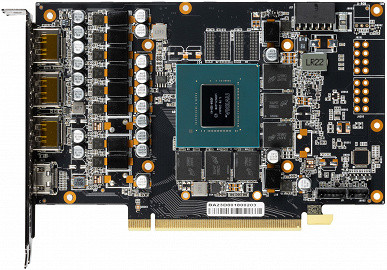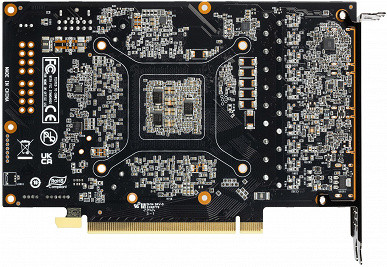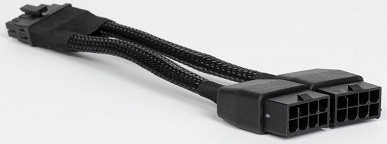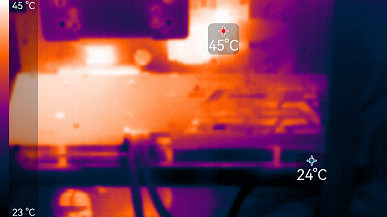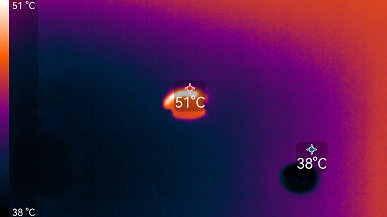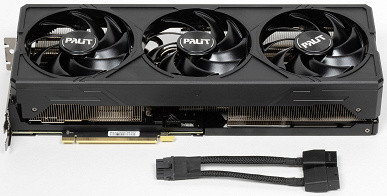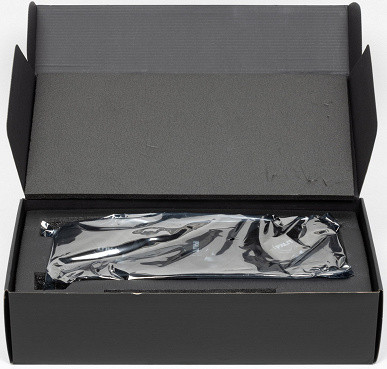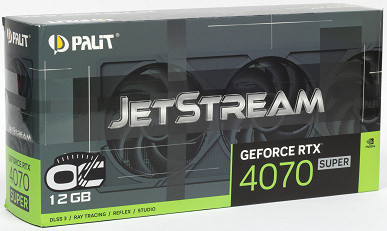Briefly about the main thing
Our test lab continues to process serially produced GeForce RTX 40 Super video cards.
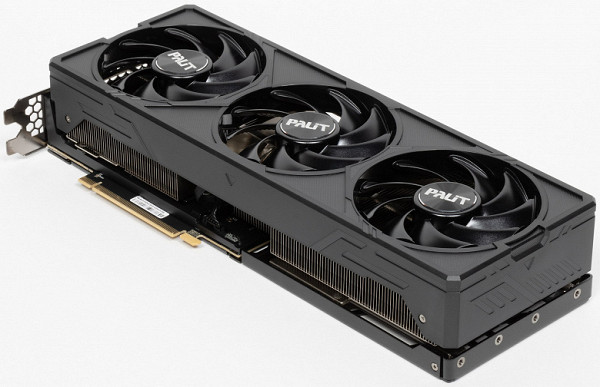
Today we will review a mid-range graphics card of the current generation — Palit GeForce RTX 4070 Super from the JetStream series. This series features an effective, although sometimes overly bulky cooling system, completely devoid of backlighting.
Before moving on to detailed tests, we will provide brief information on the performance of the entire family to which this accelerator belongs, as well as its competitors. All this will be assessed by us subjectively on a seven-point scale.
Games without ray tracing (classic rasterization):

Without ray tracing, the GeForce RTX 4070 Super delivers excellent gaming comfort at high graphics settings in all three resolutions, although the comfort level may decrease slightly in some complex games at 4K. The GeForce RTX 4070 Super confidently competes with the Radeon RX 7800 XT.
As for the model from Palit, thanks to factory overclocking, it is on average 3.7% faster than the reference version.
Games using ray tracing and DLSS/FSR/XeSS:
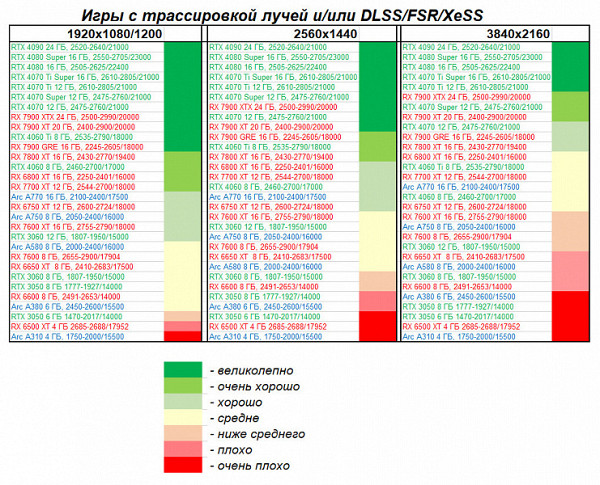
Enabling ray tracing reduces performance, but technologies such as Nvidia DLSS, AMD FSR, and Intel XeSS, which are already almost universally implemented in modern games, significantly help to compensate for this decrease. As a result, for powerful cards like the GeForce RTX 4070 Super/Ti, the previous conclusions on resolutions remain relevant. At the same time, the GeForce RTX 4070 Super even catches up with the flagship model of the latest generation from AMD — the Radeon RX 7900 XTX.
Card characteristics
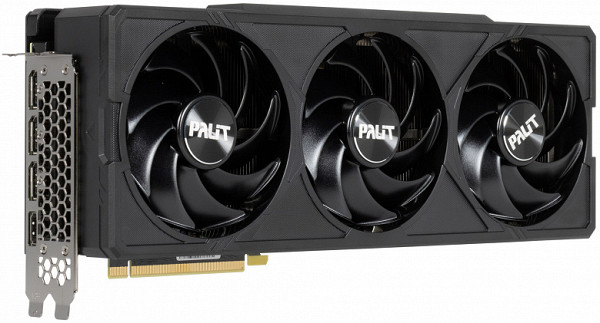
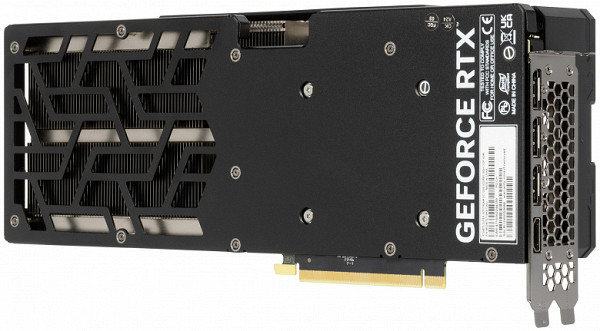
Palit Microsystems (Palit brand) was founded in 1988 in Taiwan. The headquarters are located in Taipei, and a large logistics center is in Hong Kong. The second office, focused on sales in Europe, is located in Germany, and production facilities are located in China. In 2005, after the de facto bankruptcy of Gainward, Palit acquired its brand and assets, creating the Palit Group holding. Within this holding, another office was opened in Shenzhen for sales in the Chinese market. Today, Palit Group manages several brands and trademarks.
| Palit GeForce RTX 4070 Super JetStream OC 12GB 192-bit GDDR6X | ||
|---|---|---|
| Parameter | Meaning | Nominal value (reference) |
| GPU | GeForce RTX 4070 Super (AD104) | |
| Interface | PCI Express x16 4.0 | |
| GPU Operating Frequency (ROPs), MHz | 2640(Boost)—2835(Max) | 2475(Boost)—2760(Max) |
| Memory frequency (physical (effective)), MHz | 2625 (21000) | 2625 (21000) |
| Memory bus width, bit | 192 | |
| Number of computing units in a GPU | 56 | |
| Number of operations (ALU/CUDA) in a block | 128 | |
| Total number of ALU/CUDA blocks | 7168 | |
| Number of texture units (BLF/TLF/ANIS) | 224 | |
| Number of rasterization units (ROP) | 80 | |
| Number of Ray Tracing Blocks | 56 | |
| Number of tensor blocks | 224 | |
| Dimensions, mm | 330×130×64 | 300×130×55 |
| The number of slots in the system unit occupied by the video card | 4 | 3 |
| Color of PCB | black | black |
| Peak power consumption in 3D, W | 242 | 225 |
| Power consumption in 2D mode, W | 35 | 35 |
| Power consumption in sleep mode, W | 11 | 11 |
| Noise level in 3D (maximum load), dBA | 30.4 | 31.0 |
| Noise level in 2D (video viewing), dBA | 18.0 | 18.0 |
| Noise level in 2D (idle), dBA | 18.0 | 18.0 |
| Video outputs | 1×HDMI 2.1, 3×DisplayPort 1.4a | 1×HDMI 2.1, 3×DisplayPort 1.4a |
| Support for multiprocessor operation | No | |
| Maximum number of receivers/monitors for simultaneous image output | 4 | 4 |
| Power: 8-pin connectors | 0 | 0 |
| Power: 6-pin connectors | 0 | 0 |
| Power: 16-pin connectors | 1 | 1 |
| Weight of the card with the delivery set (gross), kg | 1.93 | 2.0 |
| Net weight of the card, kg | 1.42 | 1,2 |
| Max Resolution/Frequency, DisplayPort | 3840×2160@144 Hz, 7680×4320@60 Hz | |
| Maximum Resolution/Frequency, HDMI | 3840×2160@144 Hz, 7680×4320@60 Hz |
Memory
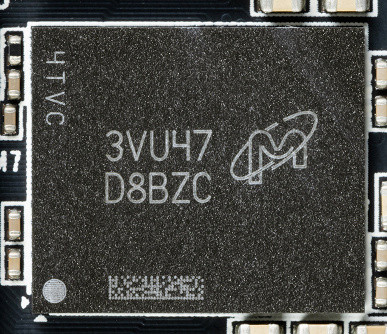
The video card is equipped with 12 GB of GDDR6X SDRAM memory, which is located in six 16 Gbit chips on the front side of the printed circuit board. The memory chips used are manufactured by Micron (MT61K512M32KPA-21/D8BZC) and are designed for a nominal operating frequency of 2625 MHz (21000 MHz effective).
Features of the card and comparison with Palit GeForce RTX 4070 Super Dual (12GB)
We compare this card to the Dual model from the same manufacturer on the same GPU to make sure they are identical and there are no differences.
The graphics core is marked AD104-350 and was released in week 46 of 2023.
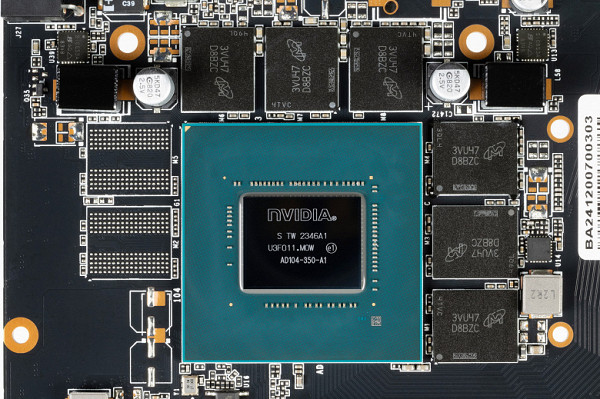
The total number of power phases in the Palit GeForce RTX 4070 Super JetStream OC card is 10 (8+2).

The core power supply is shown in green, and the memory power supply is shown in red. All PWM controllers are located on the back side of the PCB.
The core power supply is controlled by the uP9512R PWM controller from uPI Semiconductor, distributed over 8 phases.
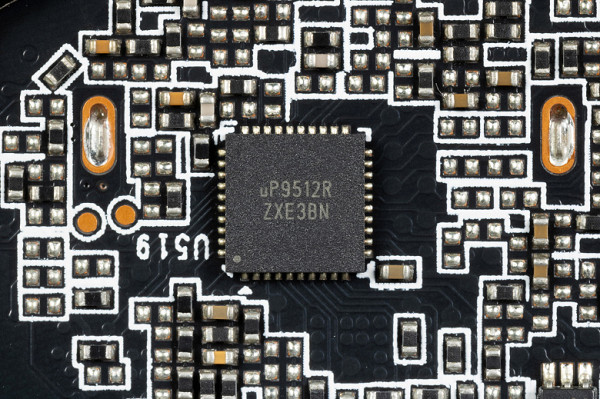
The power supply of the memory chips is controlled by the uP9529Q PWM controller (uPI Semiconductor).

The power converter uses DrMOS transistor assemblies — in this case SiC653A (Vishay), each of which is rated for a maximum of 50 A.
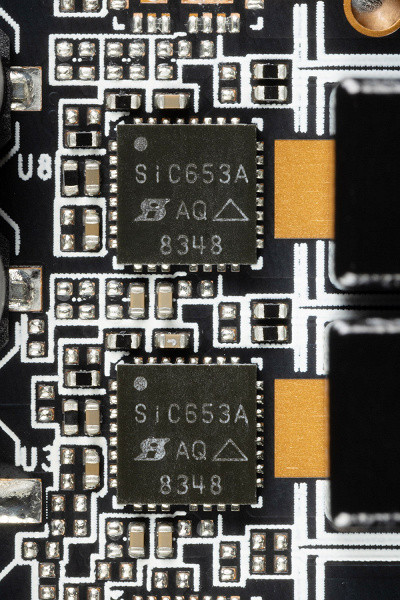
Also on the back side of the board there is a NCP45491 (On Semi) controller, which is responsible for monitoring the card (tracking voltages and temperatures).
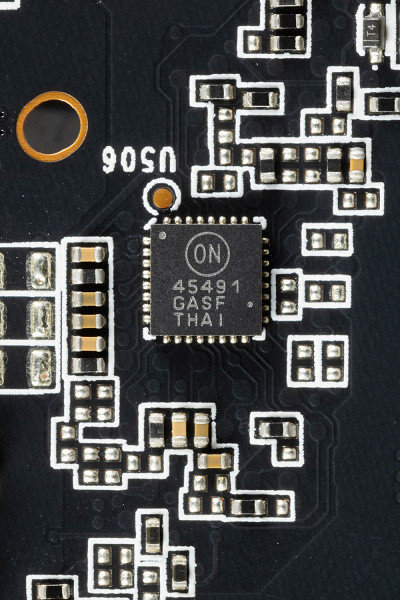
The card has no backlight, so there is no controller to control it.
The stock memory frequency corresponds to the reference, and the Boost core frequency exceeds the reference value by 6.6%. However, the maximum core frequency is only slightly higher than the reference. As a result of gaming tests, the performance of this card was on average 3.7% higher compared to the reference version.
The power consumption of the Palit card in tests reached 242 W, with peak values up to 264 W.
The power consumption limit of this card can be increased by only 4%, so I decided not to overclock it manually.
The Palit card is powered via a 16-pin PCIe 5.0 connector (12VHPWR).

The card delivery set includes an adapter for this connector from two regular 8-pin ones.
In general, the load on this adapter is small, but we still recommend using full-fledged ATX 3.0 power supplies with a 12VHPWR connector and a 16-pin cable for new-generation video cards.
It is especially worth noting the impressive dimensions of this model, especially in thickness: 6.4 cm. As a result, the video card takes up 4 slots in the system unit.

GeForce RTX 4070 Super does not support multi-graphics configurations such as SLI and does not have a special connector on the top end.
The card is controlled via the proprietary ThunderMaster utility, which we have already written about many times.
Heating and cooling
The basis of the cooling system is a massive multi-section plate nickel-plated radiator with heat pipes that distribute heat along the radiator fins.
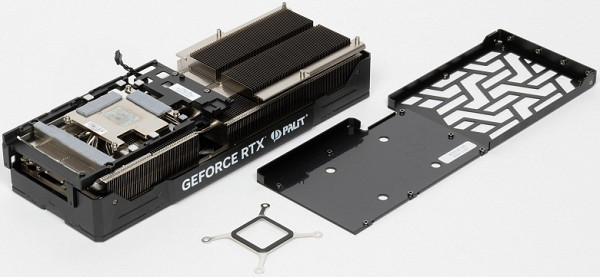
The tubes are soldered to a large nickel-plated copper plate that cools both the graphics core and the memory chips (via thermal pads). A separate heat sink is provided for cooling the VRM power converters, mounted on a massive frame screwed to the radiator. This frame also serves as a rigid element for the entire structure.

The backplate is designed solely to protect the PCB and is part of the overall design.
The radiator has a shroud with three 100mm fans. Each fan has 9 blades and operates at one speed by default. However, using the ThunderMaster software, you can configure the fans to operate separately for two groups: the central one and the two outer ones.

The radiator fins are made using YFormula Fins technology. They have different angles of inclination depending on their location in the radiator, which improves the air flow and increases the contact area between the air and the radiator fins.
The cooler is significantly longer than the PCB, so the right fan blows through the radiator at the rear of the card.

The fans stop at low load on the video card, if the GPU temperature drops below 50 degrees, and the temperature of the memory chips is below 80 degrees. When the PC starts, the fans work, but after loading the video driver, the operating temperature is checked, and the fans turn off if the temperature allows it.
Temperature monitoring:
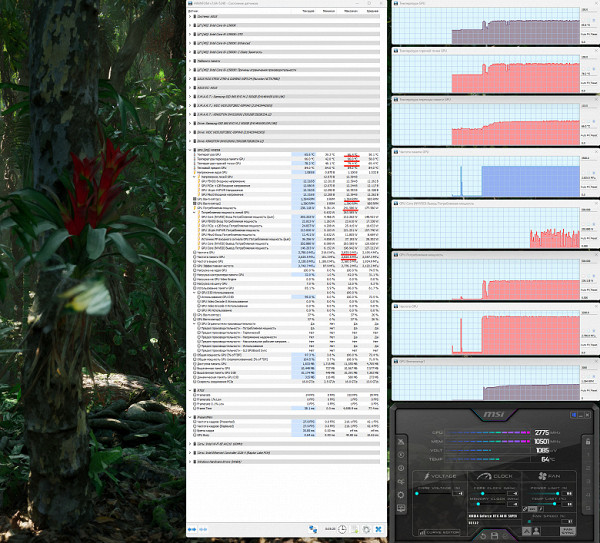
After two hours of load, the maximum core temperature did not exceed 66 degrees (at the hottest point — 79 °C), and the temperature of the memory chips was 66 degrees. This is a very good result for video cards of this level. The card's power consumption reached 242 W. Let us remind you that the safe limit for the GDDR6X memory temperature is 105 °C.
We recorded and accelerated 50 times the 8-minute warm-up of the card.
The maximum heating was observed in the central part of the PCB and at the PCIe connector.
It is worth remembering that the heat generated by the card remains inside the system unit, so using a case with good ventilation is highly desirable.
Noise
The noise measurement method assumes that the room is completely soundproofed and reverberations are reduced to a minimum. The system unit in which the video card noise is measured does not have additional fans and does not create mechanical noise. The background level is 18 dBA, which corresponds to the noise level in the room and the noise meter. Measurements are taken at a distance of 50 cm from the video card, at the level of the cooling system.
Measurement modes:
- 2D idle mode: an Internet browser with the iXBT.com website, Microsoft Word and several Internet communicators are open.
- 2D mode with watching movies: SmoothVideo Project (SVP) is used for hardware decoding with insertion of intermediate frames.
- 3D mode with maximum load: the FurMark test is performed.
Noise level assessment:
- Less than 20 dBA: relatively silent
- 20 to 25 dBA: very quiet
- 25 to 30 dBA: quiet
- 30 to 35 dBA: clearly audible
- 35 to 40 dBA: loud, but bearable
- Above 40 dBA: very loud
In idle mode in 2D, the temperature did not exceed 40 ° C, the fans did not work, the noise level corresponded to the background — 18 dBA.
When watching a movie with hardware decoding, the noise level remained the same.
In maximum load mode in 3D, the temperature reached 66/79/66 ° C (core / hot spot / memory). The fans worked at 1394 rpm, the noise level increased to 30.4 dBA, which is on the border between quiet and clearly audible.
Noise spectrogram:

Backlight
The map has no backlight.
Delivery set and packaging
In addition to the card itself, the delivery package only includes a power adapter.
Conclusions
Palit GeForce RTX 4070 Super JetStream OC (12 GB) is a mid-range graphics card in the GeForce RTX 40 series of accelerators. It stands out for its simple design and lack of backlighting, which makes it suitable for owners of system units without transparent panels or for those who place the PC out of sight, for example, under the table.
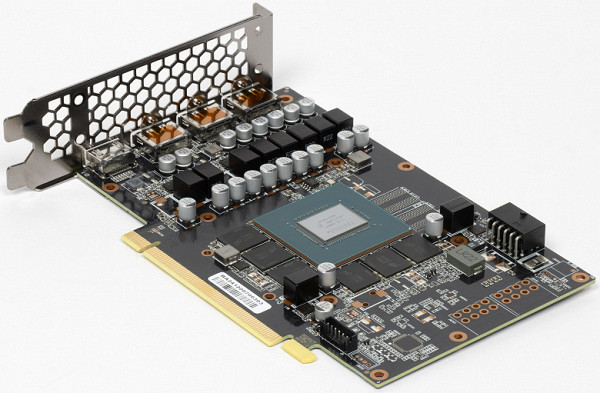
The Palit GeForce RTX 4070 Super JetStream OC consumes up to 250 W and is equipped with a powerful, efficient and fairly quiet cooling system. Its dimensions are 33 cm in length and 13 cm in height, and its thickness takes up 4 slots in the case. Video outputs include 3 DP 1.4a ports and 1 HDMI 2.1.
A 16-pin PCIe 5.0 connector is used for power supply. An adapter for PCIe 2.0 connectors (two such connectors) is included in the kit, but it is recommended to use ATX 3.0 power supplies with PCIe 5.0 support and a 12VHPWR cable.
The manufacturer provides a 3-year warranty on this card.
The GeForce RTX 4070 Super is great for gaming at resolutions up to 4K with maximum graphics settings in classic games without ray tracing. In complex games at 4K, comfort may decrease slightly. For games with ray tracing and DLSS/FSR/XeSS support, the card provides excellent quality at 1080p and 1440p resolutions, and for similar comfort in 4K, DLSS 3 support will be required. In games without scaling, comfort will be limited to 1440p resolution.
The card supports HDMI 2.1, which allows you to output 4K images with 120 FPS or 8K resolution via a single cable. There is also support for hardware decoding of AV1 and RTX IO technology for fast transfer and decompression of data from drives to the GPU. However, the DisplayPort version remains 1.4a.


